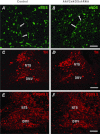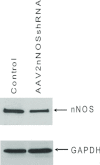Decreased expression of neuronal nitric oxide synthase in the nucleus tractus solitarii inhibits sympathetically mediated baroreflex responses in rat
- PMID: 22687614
- PMCID: PMC3547269
- DOI: 10.1113/jphysiol.2012.237966
Decreased expression of neuronal nitric oxide synthase in the nucleus tractus solitarii inhibits sympathetically mediated baroreflex responses in rat
Abstract
Despite numerous studies it remains controversial whether nitric oxide (NO·) synthesized by neuronal NOS (nNOS) plays an excitatory or inhibitory role in transmission of baroreflex signals in the nucleus tractus solitarii (NTS). In the current studies we sought to test the hypothesis that nNOS is involved in excitation of baroreflex pathways in NTS while excluding pharmacological interventions in assessing the influence of nNOS. We therefore developed, validated and utilized a short hairpin RNA (shRNA) to reduce expression of nNOS in the NTS of rats whose baroreflex activity was then studied. We demonstrate downregulation of nNOS through transduction with adeno-associated virus type 2 (AAV2) carrying shRNA for nNOS. When injected bilaterally into NTS AAV2nNOSshRNA significantly reduced reflex tachycardic responses to acute hypotension while not affecting reflex bradycardic responses to acute increases of arterial pressure. Control animals treated with intravenous propranolol to block sympathetically mediated chronotropic responses manifested the same baroreflex responses as animals that had been treated with AAV2nNOSshRNA. Neither AAV2 eGFP nor AAV2nNOScDNA affected baroreflex responses. Blocking cardiac vagal influences with atropine similarly reduced baroreflex-mediated bradycardic responses to increases in arterial pressure both in control animals and in those treated with AAV2nNOSshRNA. We conclude that NO· synthesized by nNOS in the NTS is integral to excitation of baroreflex pathways involved in reflex tachycardia, a largely sympathetically mediated response, but not reflex bradycardia, a largely parasympathetically mediated response. We suggest that, at the basal state, nNOS is maximally engaged. Thus, its upregulation does not augment the baroreflex.
Figures







References
-
- Alegria-Schaffer A, Lodge A, Vattem K. Performing and optimizing Western blots with an emphasis on chemiluminescent detection. Methods Enzymol. 2009;463:573–599. - PubMed
-
- Allen AM, Dosanjh JK, Erac M, Dassanayake S, Hannan RD, Thomas WG. Expression of constitutively active angiotensin receptors in the rostral ventrolateral medulla increases blood pressure. Hypertension. 2006;47:1054–1061. - PubMed
-
- Atkinson L, Batten TF, Corbett EK, Sinfield JK, Deuchars J. Subcellular localization of neuronal nitric oxide synthase in the rat nucleus of the solitary tract in relation to vagal afferent inputs. Neuroscience. 2003;118:115–122. - PubMed
-
- Bauman NM, Wang D, Sandler AD, Luschei ES. Response of the cricothyroid and thyroarytenoid muscles to stereotactic injection of substance P into the region of the nucleus tractus solitarius in developing dogs. Ann Otol Rhinol Laryngol. 2000;109:1150–1156. - PubMed
-
- Carvalho TH, Lopes OU, Tolentino-Silva FR. Baroreflex responses in neuronal nitric oxide synthase knockout mice (nNOS) Auton Neurosci. 2006;126–127:163–168. - PubMed
Publication types
MeSH terms
Substances
Grants and funding
LinkOut - more resources
Full Text Sources

